What Is the Keystone XL Pipeline?
How a single pipeline project became the epicenter of an enormous environmental, public health, and civil rights battle.
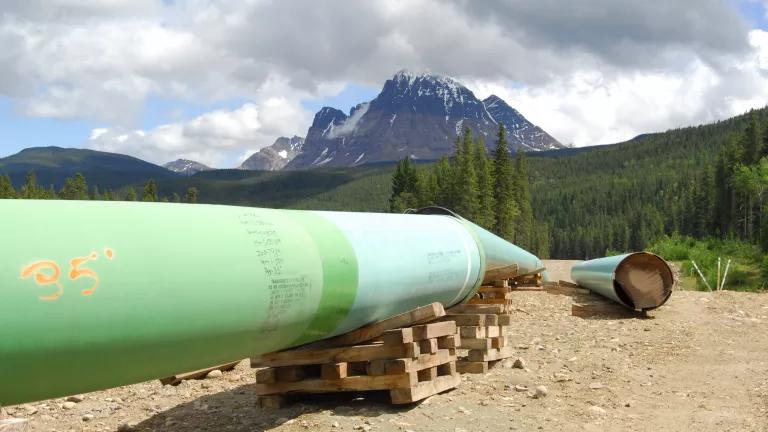
Pipeline under construction in Alberta, Canada
The takedown of the notorious Keystone XL (KXL) tar sands pipeline will go down as one of this generation’s most monumental environmental victories. After more than 10 years of tenacious protests, drawn-out legal battles, and flip-flopping executive orders spanning three presidential administrations, the Keystone XL pipeline is now gone for good. The project’s corporate backer—the Canadian energy infrastructure company TC Energy—officially abandoned the project in June 2021 following President Joe Biden’s denial of a key permit on his first day in office. But the path to victory wasn’t always clear. Many had hoped that the disastrous project was finally done for in November 2015, when the Obama administration vetoed the pipeline—acknowledging its pervasive threats to climate, ecosystems, drinking water sources, and public health. But immediately after taking office, President Donald Trump brought the zombie project back to life, along with the legal battles against it. By the time President Biden took office in 2021, ready to fulfill his campaign promise to revoke the cross-border permit, the dirty energy pipeline had become one of the foremost climate controversies of our time.
Here’s everything you need to know about the historic KXL fight–and why the pipeline’s cancellation has had no impact on current oil prices.
What is Keystone XL?
The Keystone XL pipeline extension, proposed by TC Energy (then TransCanada) in 2008, was initially designed to transport the planet’s dirtiest fossil fuel, tar sands oil, to market—and fast. As an expansion of the company’s existing Keystone Pipeline System, which has been operating since 2010 (and continues to send Canadian tar sands crude oil from Alberta to various processing hubs in the middle of the United States), the pipeline promised to dramatically increase capacity to process the 168 billion barrels of crude oil locked up under Canada’s boreal forest. It was expected to transport 830,000 barrels of Alberta tar sands oil per day to refineries on the Gulf Coast of Texas. From the refineries, the oil would be sent chiefly overseas—not to gasoline pumps in the United States.
Keystone XL and tar sands
Some three million miles of oil and gas pipelines already run through our country, but KXL wasn’t your average pipeline, and tar sands oil isn’t your average crude. It's derived from a sludgy, sticky deposit found beneath the wilds of northern Alberta’s boreal forest. These sands contain bitumen, a gooey type of petroleum that can be converted into fuel. It’s no small feat extracting oil from tar sands, and doing so comes with steep environmental and economic costs. Nevertheless, in the mid-2000s, with gas prices on the rise, oil companies ramped up production and sought additional ways to move their product from Canada’s remote tar sands fields to midwestern and Gulf Coast refineries.
Keystone XL pipeline map
The proposed Keystone XL extension actually comprised two segments. The first, a southern leg, had already been completed and now runs between Cushing, Oklahoma, and Port Arthur, Texas. Opponents of this project—now called the Gulf Coast Pipeline—say that TC Energy took advantage of legal loopholes to push the pipeline through, obtaining authorization under a U.S. Army Corps of Engineers nationwide permit and dodging the more rigorous vetting process for individual permits, which requires public input. The second segment was the hotly contested 1,209-mile northern leg—a shortcut of sorts—that would have run from Hardisty, Alberta, through Montana and South Dakota to Steele City, Nebraska.
In 2015, the U.S. State Department, under President Barack Obama, declined to grant the northern leg of the Keystone XL project the permit required to construct, maintain, and operate the pipeline across the U.S.–Canada border—a permit that President Trump later granted and President Biden once again revoked.
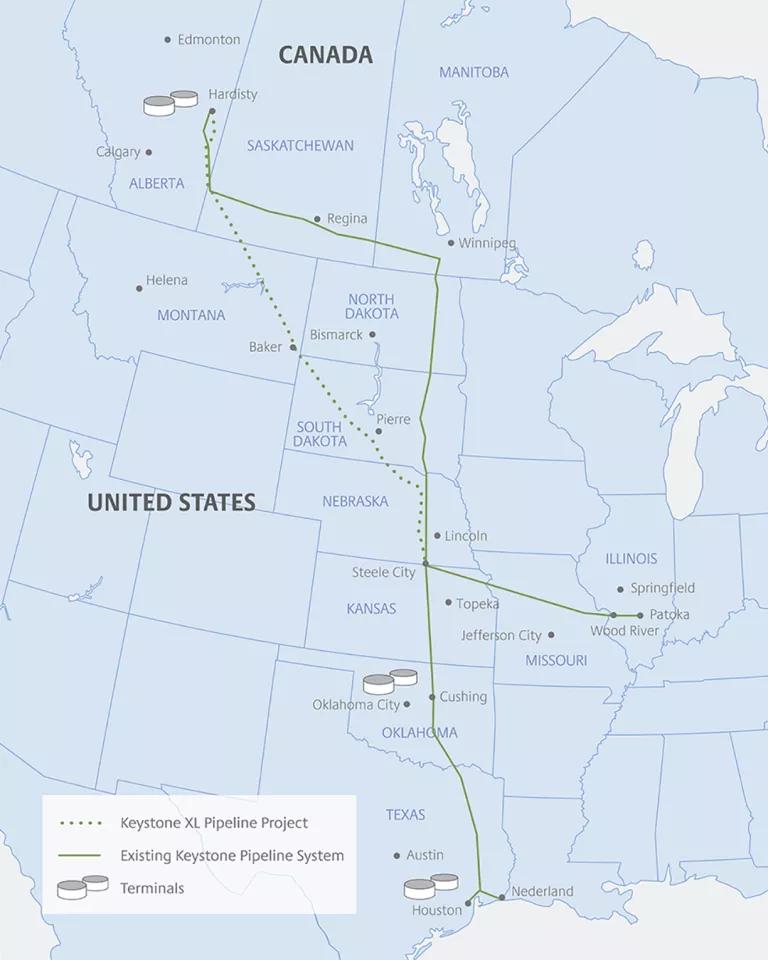
Source: keystonexl.com
Keystone pipeline, gas prices, and oil exports
Dirty energy lobbyists claimed developing tar sands would protect our national energy security and bring U.S. fuel prices down. But environmental reviews by both the Obama and Trump administrations concluded that the Keystone XL pipeline would not have lowered gasoline prices. NRDC and its partners also found the majority of Keystone XL oil would have been sent to markets overseas—aided by a 2015 reversal of a ban on crude oil exports.
This lines up with an industry trend: Oil and gas companies are exporting 8.4 million barrels of crude oil and refined fuels every single day. That’s up nearly threefold from a decade ago, and an amount equal to 42 percent of our consumption. And these exports are more than 10 times the capacity of the proposed Keystone XL pipeline.
Keystone XL pipeline environmental impact
Leaks and the pipeline
Tar sands oil is thicker, more acidic, and more corrosive than lighter conventional crude, and this ups the likelihood that a pipeline carrying it will leak. Indeed, one study found that between 2007 and 2010, pipelines moving tar sands oil in Midwestern states spilled three times more per mile than the U.S. national average for pipelines carrying conventional crude. Since it first went into operation in 2010, TC Energy’s original Keystone Pipeline System has leaked more than a dozen times; one incident in North Dakota sent a 60-foot, 21,000-gallon geyser of tar sands oil spewing into the air. Less than two years before the project was finally pulled, the Keystone tar sands pipeline was temporarily shut down after a spill in North Dakota of reportedly more than 378,000 gallons in late October 2019. And the risk that Keystone XL would have spilled was heightened because of the extended time the pipe segments were left sitting outside in stockpiles. “A study published in early 2020, co-authored by TC Energy’s own scientists, found that the anti-corrosion coating on the project’s pipes was damaged from being stored outside and exposed to the elements for the last decade,” notes NRDC senior attorney Jaclyn Prange, who spent years working on KXL litigation.
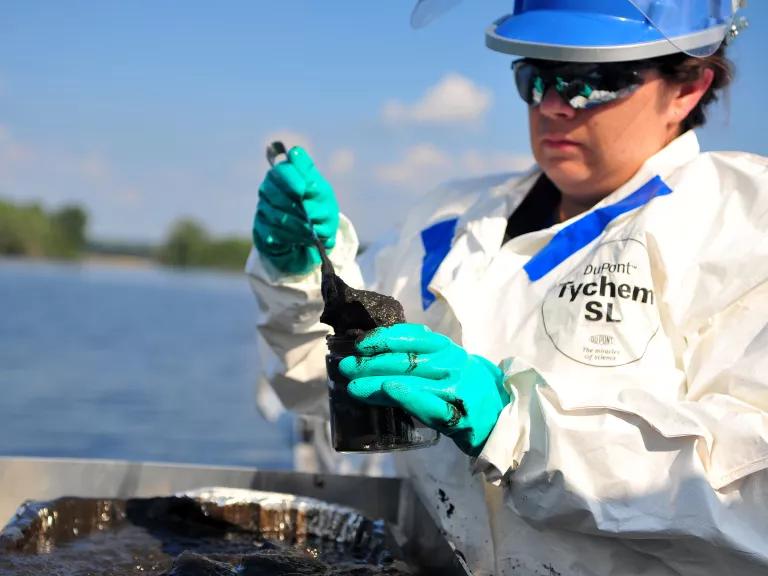
EPA staff perform oil and sediment sampling near Battle Creek, Michigan, after the Kalamazoo spill.
U.S. Coast Guard Petty Officer Second Class Lauren Jorgensen
Complicating matters, leaks can be difficult to detect. And when tar sands oil does spill, it’s more difficult to clean up than conventional crude because it immediately sinks to the bottom of the waterway. People and wildlife coming into contact with tar sands oil are exposed to toxic chemicals, and rivers and wetland environments are at particular risk from a spill. (For evidence, note the 2010 tar sands oil spill in Kalamazoo River, Michigan, a disaster that cost Enbridge more than a billion dollars in cleanup fees and took six years to settle in court.) Keystone XL would have crossed agriculturally important and environmentally sensitive areas, including hundreds of rivers, streams, aquifers, and water bodies. One was Nebraska’s Ogallala Aquifer, which provides drinking water for millions as well as 30 percent of America’s irrigation water. A spill would have been devastating to the farms, ranches, and communities that depend on these crucial ecosystems. Even worse, building Keystone XL would have meant enduring those risks just to send the fuel to our overseas rivals—and the profits to Big Oil.
What is tar sands oil?
All facets of the tar sands industry pose a threat to the environment. Its mines are a blight on Canada’s boreal, where mining operations dig up and flatten forests to access the oil below, destroying wildlife habitat and one of the world’s largest carbon sinks. The mining depletes and pollutes freshwater resources, creates massive ponds of toxic waste, and threatens the health and livelihood of the First Nations people who live near them. Refining the sticky black gunk produces piles of petroleum coke, a hazardous, coal-like by-product. What’s more, the whole process of getting the oil out and making it usable creates three to four times the carbon pollution of conventional crude extraction and processing. “This isn’t your grandfather’s typical oil,” says Anthony Swift, director of NRDC’s Canada project. “It’s nasty stuff.”
Keystone XL and climate change
A fully realized Keystone XL would have led to more mining of that “nasty stuff” by accelerating the pace at which it’s produced and transported. (Indeed, Keystone XL was viewed as an essential ingredient in the oil industry’s plans to triple tar sands production by 2030.)
It would also have led to greater greenhouse gas emissions—which, the latest scientific reports makes clear, we simply can’t afford if we’re to avoid the most catastrophic climate impacts. The U.S. Environmental Protection Agency (EPA) initially stated that, on a wells-to-wheels basis, tar sands oil emits 17 percent more carbon than other types of crude, but several years later, the State Department revised this number upward, stating that the emissions could be “5 percent to 20 percent higher than previously indicated.” That means burdening the planet with an extra 178.3 million metric tons of greenhouse gas emissions annually, the same impact as 38.5 million passenger vehicles or 45.8 coal-fired power plants. Finally, massive fossil fuel infrastructure investments like KXL undermine efforts to minimize global warming and prioritize clean energy like wind and solar. Leading climate scientist and former NASA researcher James Hansen has warned that fully exploiting Canada’s tar sands reserves by moving forward with these projects would mean “game over” for our climate. In short, tar sands oil represents no small threat to our environment, and our best stance against it, as the rallying cry goes, is to “keep it in the ground.”
Keystone XL pipeline controversy and false claims
Opposition to Keystone XL centered on the devastating environmental consequences of the project. The pipeline faced more than a decade of sustained protests from environmental activists and organizations; Indigenous communities; religious leaders; and the farmers, ranchers, and business owners along its proposed route. One such protest, a historic act of civil disobedience outside the White House in August 2011, resulted in the arrest of more than 1,200 demonstrators. “This is not a pipeline to America,” said the late civil rights activist Julian Bond, among the many arrested. “It’s a pipeline through America, and it threatens to be a disaster for us if it leaks poisons on the way.” Leading scientists and economists came out in opposition to the project, in addition to unions and world leaders such as the Dalai Lama, Archbishop Desmond Tutu, and former president Jimmy Carter (together, these and other Nobel laureates have written letters against the project). In 2014, more than two million comments urging a rejection of the pipeline were submitted to the U.S. Department of State during a 30-day public comment period.
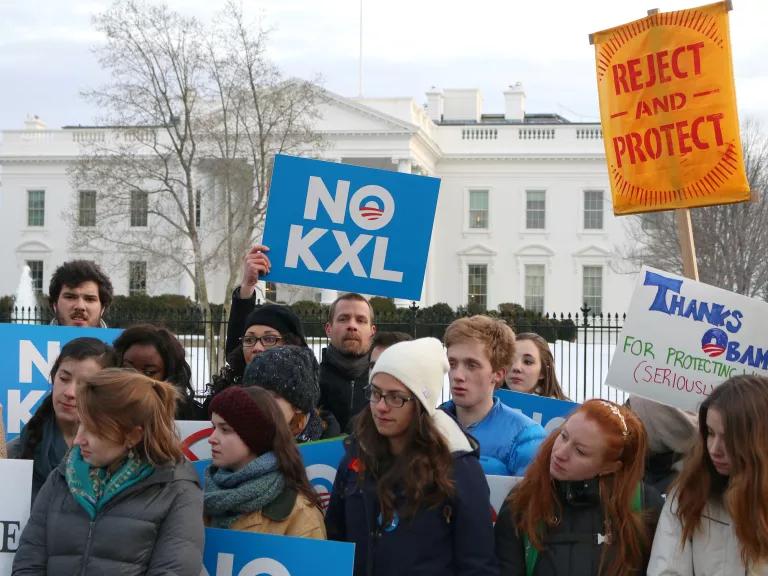
Rocky Kistner/NRDC
But the groundswell of public protest was up against a formidable opponent–hundreds of millions spent on lobbying by the fossil fuel industry. In the two years leading up to the November 2014 midterm elections, the fossil fuel industry spent more than $721 million to court allies in Congress. When industry-friendly politicians took charge of both congressional houses in January 2015, their first order of business was to pass a bill to speed up approval of Keystone XL. (That effort failed.) Later, fossil fuel companies funnelled millions into Trump’s 2017 inauguration ceremony, days after which he brought the Keystone XL project back from the dead, and ramped up federal lobbying efforts in the first months of his administration.
“So what if there’s no pipeline? Big Oil will find a way.”
One of the central arguments made by pipeline pushers was that tar sands expansion will move forward with or without Keystone XL. This has proved to be untrue. Dealing in tar sands oil is an expensive endeavor. It’s costly both to produce and to ship, particularly by rail, which would be an alternative to Keystone XL. Indeed, moving crude by rail to the Gulf costs substantially more than moving it by pipe. For companies considering whether to invest in a long-lived tar sands project (which could last for 50 years), access to cheap pipeline capacity plays a major role in the decision to move forward or not. Without Keystone XL, the tar sands industry has been forced to cancel projects rather than shift to rail, subsequently leaving more of the earth’s dirtiest fuel in the ground where it belongs.
The industry also falsely claimed that the pipeline would be a big source of jobs.
When TC Energy said the pipeline would create nearly 119,000 jobs, a State Department report instead concluded the project would require fewer than 2,000 two-year construction jobs and that the number of full-time, permanent jobs would hover around 35 after construction.
President Trump and the Keystone XL pipeline
When the Obama administration refused to grant the cross-border permit necessary to build TC Energy’s Keystone XL oil pipeline in November 2015, it struck a blow against polluting powers and acknowledged the consensus on this misguided project from a wide swath of communities, experts, and organizations. The decision echoed a seven-year State Department review process with EPA input that concluded the pipeline would fail to serve national interests.
Upon entering office, President Trump—with his pro-polluter cabinet of fossil fuel advocates, billionaires, and bankers—quickly demonstrated that his priorities differed. On his fourth day in office, Trump signed an executive order to allow Keystone XL to move forward. On March 28, 2017, his State Department illegally approved a cross-border permit for the pipeline, reversing the Obama administration’s prior determination that KXL would not serve the national interest. When that failed—thanks to a lawsuit brought by NRDC and other groups—Trump reissued the cross-border permit himself. “We would score a victory, and it would have huge ramifications for holding off construction at critical times,” says NRDC attorney Cecilia Segal, who has worked on KXL litigation since 2017. “But then the Trump administration would do something to undercut us outside of court.” The administration also attempted to issue other permits for the project, all based on flawed environmental analyses, eventually prompting more lawsuits, including two from NRDC and its allies.
Opposition outside the courts was swift and strong as well. Farmers, ranchers, tribes, and conservation groups helped keep the project stalled for Trump’s full four years in office, despite his best efforts to expedite its approval.
President Biden and the end of the Keystone XL pipeline
Even as Trump and TC Energy tried to revive the pipeline, polls showed that a majority of Americans opposed it. The market case had also deteriorated. Low oil prices and increasing public concern over the climate led Shell, Exxon, Equinor (then Statoil), and Total to either sell their tar sands assets or whittle them down. Meanwhile, major new tar sands projects stopped moving forward, despite investments from the government of Alberta, Canada. For example, in 2020, Teck Resources withdrew its 10-year application to build the largest tar sands mine in history, citing growing concern surrounding climate change in global markets.
On the campaign trail, Biden vowed to cancel the Keystone XL cross-border permit should he win the presidency—and on his first day in office, he made good on that promise. The revoked permit became the final nail in the pipeline’s coffin. By that point, Keystone XL faced an unfriendly administration, numerous legal challenges, declining oil prices, worsening climate impacts, and a growing movement of climate organizers—along the pipeline’s route and around the world—unwilling to look the other way. In June 2021, TC Energy announced that it was abandoning its plans for building the pipeline for good—putting an end to a fossil fuel project that had loomed over waterways, communities, and the climate for more than a decade. “Keystone XL was a terrible idea from the start,” Swift said. “It’s time to accelerate our transition to the clean energy sources that will power a prosperous future.”
While the tar sands industry was once seen as an unbeatable opponent in a David-and-Goliath fight, the victory against Keystone XL shows that the tables have begun to turn–and that more power now lies with the advocates for climate justice than ever before. “The era of building fossil fuel pipelines without scrutiny of their potential impact on climate change and on local communities is over,” Swift says.
This story was originally published on April 7, 2017, and has been updated with new information and links.
This NRDC.org story is available for online republication by news media outlets or nonprofits under these conditions: The writer(s) must be credited with a byline; you must note prominently that the story was originally published by NRDC.org and link to the original; the story cannot be edited (beyond simple things such as grammar); you can’t resell the story in any form or grant republishing rights to other outlets; you can’t republish our material wholesale or automatically—you need to select stories individually; you can’t republish the photos or graphics on our site without specific permission; you should drop us a note to let us know when you’ve used one of our stories.


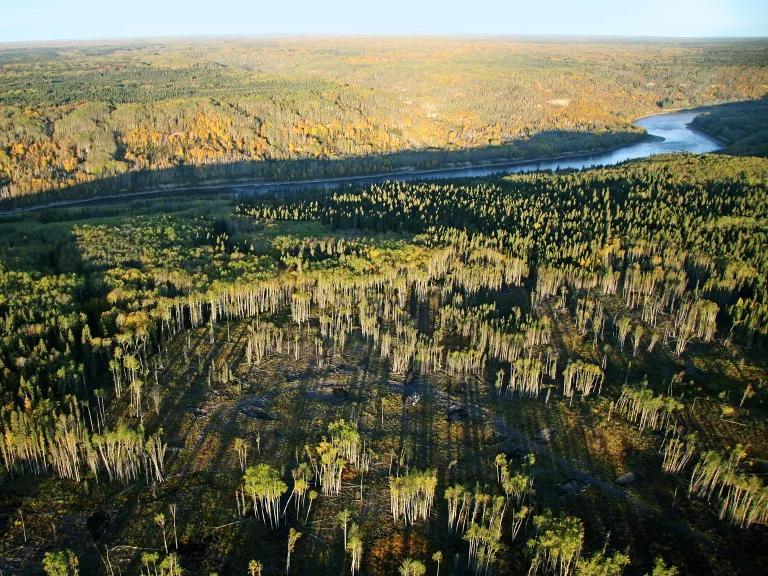
The Desire to Stop Canadian Tar Sands Transcends Borders
The Unlikely Takedown of Keystone XL
Looking for Climate Connections (and Berries) Through Traditional Indigenous Knowledge